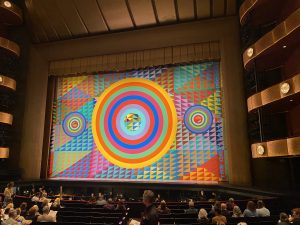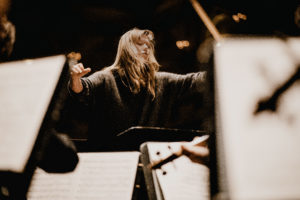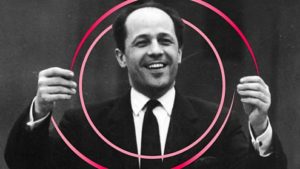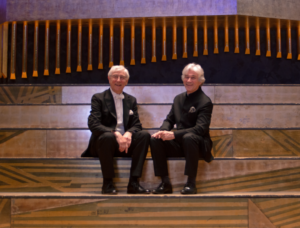
At the beginning of Copland Dance Episodes, the “new” ballet choreographed by Justin Peck of New York City Ballet, the entire company is on stage stood statuesque whilst individually clothed in a fleece mesh. It’s a really exciting initial view that promises much. If you were to see just this and the promotional video short and were asked to guess what was to come next, you would probably think that the ballet would deliver a modernist twist on Copland’s Americana. Rather disappointingly, this didn’t really happen. What followed did indeed entertain, but it was the bits of music that were cut that meant, for me, that it didn’t quite live up to its promise.
When I first heard that Peck was doing new Copland I was thrilled. Then when I later heard it was populist Copland, I was a little disappointed. What wouldn’t I give for a dance company to put on Grohg? The ballet that Copland wrote 100 years ago (between 1922-25), which has wonderful music but still (amazingly) has never been staged. Someone needs to make that happen. A large part of this “ballet” was later revamped by Copland into his Dance Symphony (a big clue to the music’s rhythmic quality is in the title). There are plenty of other options too like Dance Panels. Both of these are works that most people have never heard of. Focussing on Copland’s middle period of accessible works is a bit depressingly post Covid – i.e. safe, lacking adventure and more of a sure thing to make money.
The Peck Copland Episodes consist of Copland’s most famous works: Fanfare for the Common Man, Rodeo, Appalachian Spring and Billy the Kid. It’s a 76-minute run through of 22 separate parts without an intermission. Each of the dance episodes are given a new name. I have tried my best to match these up below:
- The Only way out is through – Fanfare for the Common Man
- Start your engines – Buckaroo Holiday
- Tumbleweed – Corral Nocturne
- Two Birds – Saturday Night Waltz
- At the Rodeo – Hoe Down
- Phone Home – Very slowly
- Etch a sketch – Allegro
- Alone together Part 1 – The bride and her intended
- Rule of three – The revivalist and his flock
- Armor – Solo dance of the bride
- Alone together Part 2 – Meno messo
- Simple Gifts – Simple Gifts
- Alone together Part 3 – Coda
- Kismet – Coda
- Wake up slow – Coda
- The great Excavation – The open prairie
- Roundtable – Street in a frontier town
- The Amazing Race – back end of Street in a frontier town and start of Mexican Dance
- Dinner for one – Mexican Dance and Finale
- The split – back end of Mexican Dance and Finale and Prairie Night
- Shadow boxer – Gun battle
- One door closes, another opens – Billy’s death, The open prairie again
I like a lot of the names especially the opening and finale. That said, the ballet is stated as not having any particular narrative but by calling episodes Tumbleweed, At the Rodeo and Simple Gifts is hardly likely to change anyone’s pre-existing views on what pictures this music conjures up.
One thing needs to be clarified – Copland Dance Episodes: A New Ballet by Justin Peck is not all new. Peck had previously created the updated choreography for Rodeo: Four Dance Episodes in 2015 and that has had several runs already. These four episodes are exactly the same only with different costumes.

Jeffrey Gibson’s safety curtain design for Copland Dance Episodes.
The ballet begins with Fanfare for the Common Man as the overture. The multi coloured curtain designed by Jeffrey Gibson fuses his Choctaw-Cherokee heritage with club culture and queer theory. Given the obvious nod to the rainbow of colours of LGBTQ, I found it really odd that with both Rodeo and Appalachian Spring, Peck retained the gender biases of the original ballets. The Rodeo episodes are all danced by men, bar one whereas, Appalachian Spring is mainly the domain for the women dancers. I have to wonder why that wasn’t turned on its head? As a result both had an air of familiarity.
There are of course moments of great fun in Rodeo. For instance, the nice touch when one of the shorter dancers looks into the chest of the tall one (very Marty McFly and Biff from Back to the Future). There are several typical Peck flourishes where the body seemingly should go one way but goes the other. I also liked the waltz steps in Two Birds/Saturday Night Waltz and the chain of dancers reaching out to the audience but being pulled back in Tumbleweed/Corral Nocturne. The dozen or more pirouettes during At the Rodeo/Hoe Down which originally signified a sidling up to the girl in the bar are technically challenging and done well but a touch unadventurous.
Unfortunately, both Rodeo and Appalachian Spring were the truncated, well-known versions not the full ballets. This meant that any of the very interesting dissonant music was not used at all.
The Appalachian Spring section starts off in half light and finishes in half light – the set pieces at the start of Phone Home/Very slowly where the three female dancers touch the fingers of the three males, indeed do make you think of ET or Michelangelo’s David. As the harp plays its solo notes the males crumple as if shot by a tranquilizer gun. This is fine choreography and was well performed. I also liked the bit at the end of this take where the entire company point to the sky. Again, this suggests an extra-terrestrial element.

Photo credit: Erin Baiano
The finale is also a well-constructed set piece. All the dancers form a ring on the ground. One by one each dancer lifts their leg and creates a shape. I surmise that each dancer is a spoke in the wheel of life. My favourite episode was Armor danced by the females and had the most angular moves. But for me Appalachian Spring only makes sense with the Crisis and Fear in the Night sections included, I have described it as the grit that makes the pearl. My view is that this section of the ballet needed a bit more grit. As there is some obvious tells that the underlying theme of the ballet is about the break up of a relationship, it seems odd that these sections were excised. They would have fitted perfectly. Personally, I would prefer a ballet stretching over two halves with those pieces included.
Removing the narrative from Appalachian Spring and cutting the Crisis section turns the modernist work into a classical ballet that unfortunately didn’t really do it for me. I’m not sure Martha Graham or Copland (for that matter) would have approved either. Overall, I found the Appalachian Spring section dragged. I doubt that it will supplant the original choreography.
By contrast Billy the Kid was superb as it has the full mix of dancers and uses some of the more incidental parts of the ballet that were pruned from the later suite version. This enabled more variation in the choreography accentuating abstract lines. That said there are also omissions – there’s no Waltz (understandable given the waltz in Rodeo) or Celebration after Billy’s Capture. That perhaps would have integrated too much levity in this more highly charged section.
For me, there were more highlights in the Billy the Kid than elsewhere. I loved the Roundtable piece – especially when there is the game of chicken at the end – that’s really fun and got a chuckle from the audience. The highlight though was The Split/Mexican Dance and Finale and Prairie Night. This is a pas de deux which is more reflective of the promo video and more modern in every way.
There is also much greater variation in lighting in Billy the Kid. For instance, the episode Shadowboxer/Gun Battle uses silhouette to great effect. This makes it feel like the wild west has been transferred to 1920’s Chicago. I would have preferred more use of light and dark in the other sections. Instead, the white background and coloured costumes did not offer as much contrast than the promised colour of the safety curtain. (I have since read other reviews praising the lighting and the inspired use of the white floor and background. Perhaps I missed something there!)

Photo credit: Erin Baiano
The final three episodes were all danced with verve and immediacy and culminated in a terrific finale danced by the entire company.
Whilst in New York I went to see Copland Dance Episodes twice. On Saturday it got a full standing ovation. The following Thursday, only a couple of dozen people got out of their seats. On referring to the programme I noticed that many of the key roles were danced by different individuals and the second performance did seem to me to be a bit rougher around the edges. I’m not sure if this was down to the lack of continuity but there did seem to be a dip and that compounded my overall impression. I liked it well enough the first time around but Billy the Kid aside, I don’t think it would hold my attention for many more viewings. (That said, frequent readers of this blog will know that I am not so keen on the suite versions of Copland’s ballets so that’s probably a big part of this). It’s likely to be a mainstay of the NYC Ballet repertoire for a long while but I so wish it showed a more modernist inclination by including more of the stark, visceral and percussive music that Copland composed.
As a result, the unfortunate thing about the ballet is that most people in the audience will probably continue to associate Aaron Copland with mere Americana and their minds eye will drift towards a wide-open prairie in CinemaScope. It sure puts the bums on the seats and the two full houses were testament to that. I just hope that some will be inspired enough by the experience to go away and delve a little deeper into Copland’s wider body of works.
I have mentioned Grohg in the introduction and that would make a great ballet. Another option that would throw more light on Copland’s more difficult, edgy music would be a ballet that celebrates New York City. How about a ballet version of Something Wild (later revamped as Music for a Great City) where there are two main characters but options to include the full company in stunning set pieces to the incredible film cues Skyline, Subway Jam and Incarceration and Nightmares? As Copland’s more spiky works often conjure up images of Manhattan skyscapers, such a work could be truly amazing, possibly even a classic and something that would get me crossing back over the Atlantic in a snap!
Title image photo credit: Erin Baiano









Leave a Comment